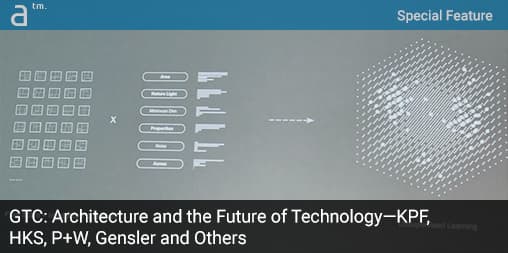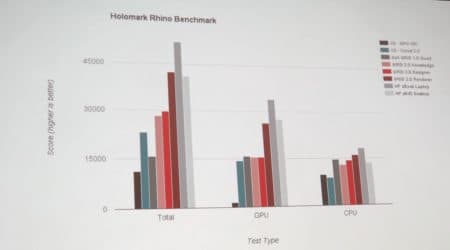Continued from page 2
How Multi-User Collaborative VR is Changing the Way Architects Design Spaces
CannonDesign’s Jimmy Rotella and Ernesto Pacheco’s panel was demonstrating how multi-user VR environments created shared experiences for collaboration in architectural building models. It covered the modeling build of the environment, basic configuration, and how it was put into production.
VR can be a lonely experience with only one person using goggles. VDI and Holodeck VR allow a multi-user experience that generates the next level of collaboration and reduces the limitations of the physical location where VR is happening—giving you a face-to-face communication with real-time interaction through the design process. You can walk through the model with a structural engineer, builder, or client. The virtual environment gives the client the ability to participate in the design process. The client can do real-time markups like using a pencil.
The Holodeck VR Process
The NVIDIA Holodesk VR process looks like this for CannonDesign. It involves moving architectural models from Autodesk Revit into Abvent’s Twinmotion then to Autodesk 3ds Max from which files are saved out to Adobe Photoshop for a round trip loop in Illustrator and back to 3ds Max and then to Holodesk VR.
CannonDesign’s presentation recommended a polycount limit for ideal performance at 50 million triangles. It also recommended an object limit of 30,000 objects and a maximum limit of unique materials at 64.
The system requirements for this process for the Holodeck include a Windows PC or workstation with an NVIDIA Quadro P6000, GeForce GTX 1080 Ti, or a GeForce Titan Xp. The CPU recommendation was Intel i7-6700 or higher, but a Xeon that is more powerful on spec could also suit the bill. 80 GB of free desk space on an SSD or very fast HDD, with 16 GB of RAM or higher, Windows 10 64-bit SP1 or higher with a separate Steam account for each system. You will also need an HTC Vive or Oculus Rift with Touch controllers.
Architosh has already published a report on the CannonDesign presentation with an interview of Rotell and Pacheco. (see: Architosh, “CannonDesign—Powering Their Design Pipeline with NVIDIA GPU Technology,” 17 Apr 2018.)
Exploring Holodeck Use Cases for AEC
This panel talked about the real world use of the Holodeck VR and how it could save time and money in the design process by solving problems before they happen.
Panelist
- Cobus Bothma, KPF
- Andrew Burdick, Ennead Architecture (formerly Polshek Partners)
- Nicholas Cameron, Perkins+Will
- Brian Hopkins, Ennead Architecture
- Jimmy Rotella, Cannon Design
Andrew Burdick, of Ennead Architecture, pointed out that not every client is going to be able to imagine a 3D space. He likes the idea that you can incorporate clients into projects and they can learn with you—sharing the model in a way to get the most honest feedback.
Nicholas Cameron, from Perkins + Will, would like to see more features included in Holodeck so it is more universally available with a better price point, easy plug and play, wireless connectivity, and more weather-related interactivity. It should be pointed out that NVIDIA’s Holodeck is currently in early access and companies must apply to get into the beta use period. You can learn more here.
The panel made a good point about whether software tools could accidentally limit the creative process while enhancing other features. When does the application hinder the design process?
GPU rendering is quicker, faster rendering, and more studios will be using it said the panel.
Autodesk BIM Cloud Workspace and Azure and Citrix Discussions
GPU virtualization in the cloud is now changing the way architects, builders, designers, and engineer’s work. This panel explored the BIM 360, Revit, and Navisworks in the Cloud through a digital workspace hosted by Citrix XenDesktop HDX Pro running on Microsoft Azure NV-series virtual machine with NVIDIA Quadro Workstation Technology.
The discussion was about how the technology allows TBI personnel to work together from any location in the world. It allows optimized 3D user experience on any device. TBI has evolved from the 2D flatland to the more advanced 3D optimization of digital data.
An Architectural Design Firm’s Journey through Virtual GPU Technology for Global Collaboration
Andrew Schilling and Jimmy Rotella from CannonDesign shared their firm’s implementation of virtualization on a global level. CannonDesign has 19 offices worldwide all tied back into one data center, everyone at the firm, wherever they are, can share projects and work on the same files.
MORE: CannonDesign—Powering Their Design Pipeline with NVIDIA GPU Technology
CannonDesign decided to virtualize because of the need for collaboration. The firm operates as a single firm, multi-office (SFMO) company. The firm’s employees have “workstation” and GPU access from anywhere including home. This creates greater flexibility and mobility for employees, and the ability to share and reallocate resources. CannonDesign needed more power for their firm with a growing demand for projects and expansion than previously obtained. They use a very mixed environment for their racked workstations. They incorporated benchmark tools to test their machines. RFO benchmark, Cinebench, Holomark, and PCMark to test overall performance.
NVIDIA’s Quadro cards are used in Cannon’s pipeline as they give staff the ability to use the GPU to do faster ray trace rendering or use real-time technologies for visualization that meet their benchmark standards.
CannonDesign uses Cisco UCS Blades in their data center. They did a cost comparative per user for their hardware purchases. Previous VDI users will see a savings of 13.5 hours per week using Revit on the Cisco hardware, which equates to $2,500.USD per week in billable hours. New servers reduce 85% server space compared to older servers. VDI users see a savings of 310 seconds in operations when rotating, orbiting, panning, or zooming. Users save 86 seconds when creating models and exporting them. RWS users see a saving of 10 seconds when doing the same with 25 seconds savings when creating models and exporting.
VDI is cost efficient for a large firm. However, what may work for CannonDesign may not work for a smaller firm. It’s always best to consider what tools you need, what hardware and software, and the number of users and projects to see if this is something your firm can incorporate.
Virtualized desktop infrastructure (VDI), for those who may not have the concept of what is going on, is server-based computing. It is the client-server model and enables centralized storage of data (files) and the applications that power that data.
next page: Four Years of GPU Accelerated VDI for AEC & Closing Comments






Reader Comments
Comments for this story are closed